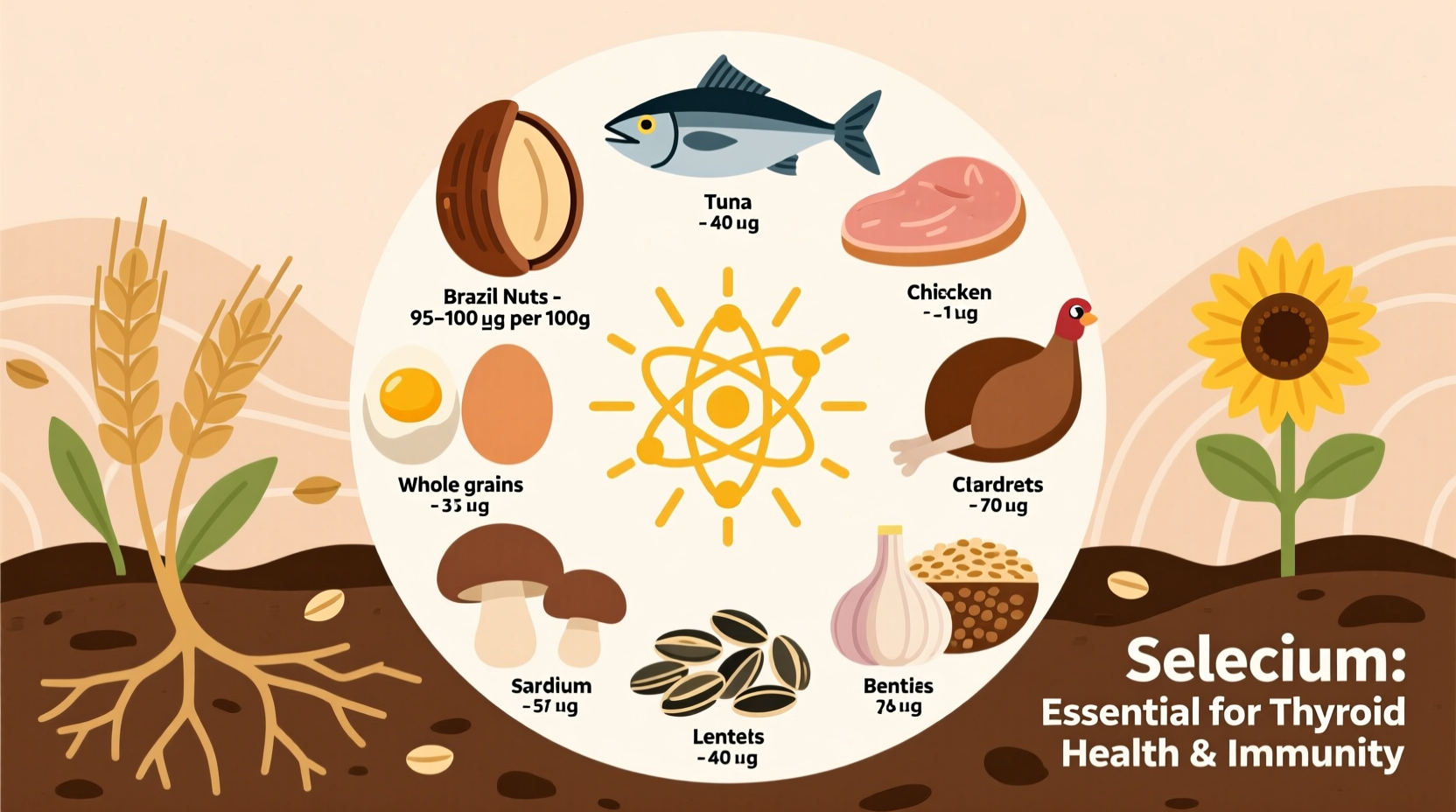Understanding which foods contain selenium is crucial for maintaining optimal thyroid function, supporting your immune system, and protecting your cells from damage. This comprehensive guide delivers precisely measured selenium content from authoritative sources, helping you make informed dietary choices without guesswork.
Why Selenium Matters for Your Health
Selenium functions as a powerful antioxidant in your body, working alongside vitamin E to combat oxidative stress. According to the National Institutes of Health, this trace mineral plays a critical role in:
- Thyroid hormone metabolism (essential for regulating metabolism)
- DNA synthesis and repair
- Protection against infection
- Reproduction and fertility support
Research published in the American Journal of Clinical Nutrition shows that adequate selenium intake correlates with reduced risk of certain cancers and cardiovascular diseases. However, balance is key—too little or too much can cause health problems.
Top Selenium Food Sources by Category
Seafood Powerhouses
Marine foods consistently rank highest for selenium content due to ocean bioaccumulation. The selenium concentration in fish directly reflects their position in the food chain.
| Food | Serving Size | Selenium (mcg) | % Daily Value |
|---|---|---|---|
| Yellowfin tuna | 3 ounces | 92 | 167% |
| Halibut | 3 ounces | 47 | 85% |
| Sardines (canned) | 3 ounces | 45 | 82% |
| Shrimp | 3 ounces | 40 | 73% |
This data comes directly from the USDA FoodData Central database (accessed September 2025), providing laboratory-verified measurements rather than estimates.
Meat and Poultry Sources
Animal proteins offer highly bioavailable selenium. The selenium content varies based on what animals consumed during their lifetime—grain-fed versus grass-fed, for example.
Organ meats like liver provide substantial selenium along with other critical nutrients. A 3-ounce serving of beef liver contains approximately 28 mcg of selenium (51% DV). For everyday consumption, lean turkey breast stands out with 31 mcg per 3-ounce serving (56% DV).
Plant-Based Selenium Options
For vegetarians and vegans, selenium availability depends heavily on soil composition where plants were grown. This creates significant regional variation—Brazil nuts from selenium-rich Brazilian soils contain vastly more selenium than those grown elsewhere.

Among plant foods, Brazil nuts reign supreme. Just one nut (approximately 5 grams) contains 68-91 mcg of selenium. However, consumption should be limited to 1-2 nuts daily to avoid exceeding the upper intake level.
How Much Selenium Do You Really Need?
Daily requirements vary by life stage and physiological condition. The National Academy of Medicine established these Dietary Reference Intakes:
- Adults (19+ years): 55 mcg daily
- Pregnant women: 60 mcg daily
- Lactating women: 70 mcg daily
- Children (9-13 years): 40 mcg daily
Notably, the Mayo Clinic reports that selenium deficiency is rare in North America due to selenium-rich soils, but certain medical conditions like Crohn's disease can impair absorption.
Special Considerations for Selenium Intake
Your optimal selenium intake depends on several contextual factors:
Geographic Location Matters
Selenium content in plant foods varies dramatically by region. Chinese studies published in Environmental Geochemistry and Health show that:
- Soils in the Northwestern US contain high selenium levels
- Chinese provinces like Shaanxi have selenium-deficient soils
- New Zealand soils generally lack sufficient selenium
This geographical variation explains why people in certain regions may need to be more conscious of their selenium intake.
Avoiding Selenium Toxicity
While deficiency causes problems, excess selenium creates serious health risks. The Tolerable Upper Intake Level is 400 mcg daily for adults. Chronic overconsumption can cause:
- Garlicky breath odor
- Nail brittleness or loss
- Hair loss
- Nervous system abnormalities
Most cases of selenium toxicity come from improper supplement use rather than food sources. The NIH reports that toxicity from dietary sources alone is extremely rare.
Practical Selenium-Boosting Strategies
Instead of focusing on individual high-selenium foods, create balanced meal patterns that naturally incorporate selenium:
- Start your day with cottage cheese (20 mcg per cup) instead of regular yogurt
- Add canned sardines to salads for lunch (45 mcg per serving)
- Include turkey in your dinner rotation (31 mcg per 3 oz)
- Snack on just one Brazil nut with your afternoon tea
For vegetarians, combine selenium sources: add sunflower seeds (19 mcg per ounce) to whole grain bread made with selenium-rich flour. Remember that cooking methods affect selenium retention—boiling leaches selenium into water, while baking preserves more.
When Supplements Make Sense
Most people don't need selenium supplements if they eat a varied diet. However, certain situations warrant consideration:
- Individuals with gastrointestinal disorders affecting absorption
- People undergoing kidney dialysis
- Those living in regions with selenium-deficient soils
- Patients with HIV who often have lower selenium levels
Always consult with a healthcare provider before starting selenium supplements. The NIH warns that high-dose selenium supplements (200 mcg+) may increase diabetes risk in already sufficient individuals.











 浙公网安备
33010002000092号
浙公网安备
33010002000092号 浙B2-20120091-4
浙B2-20120091-4